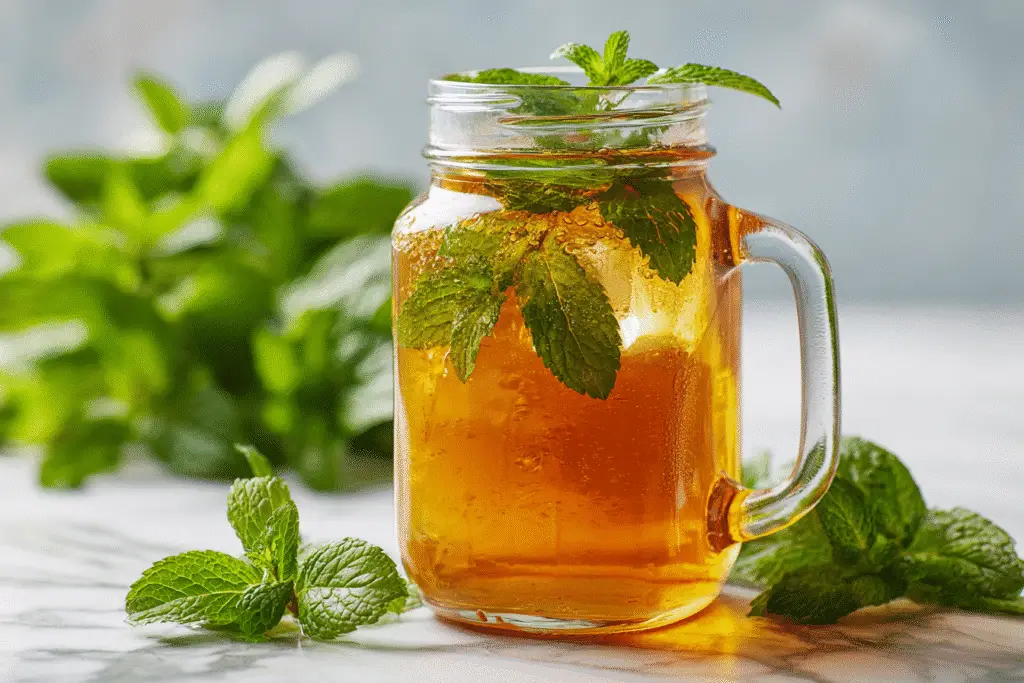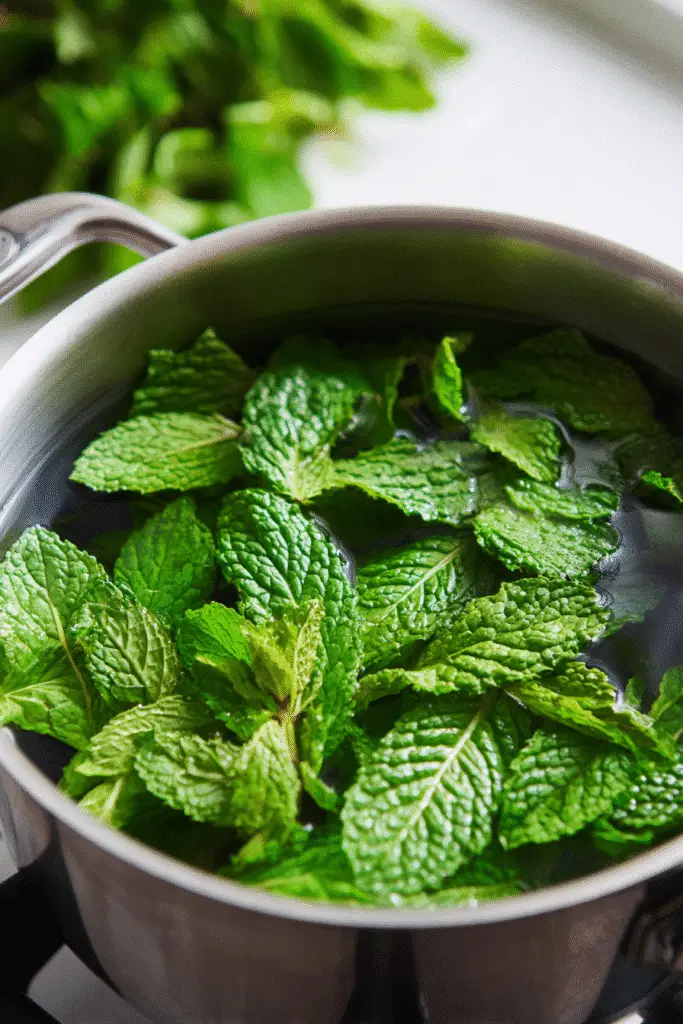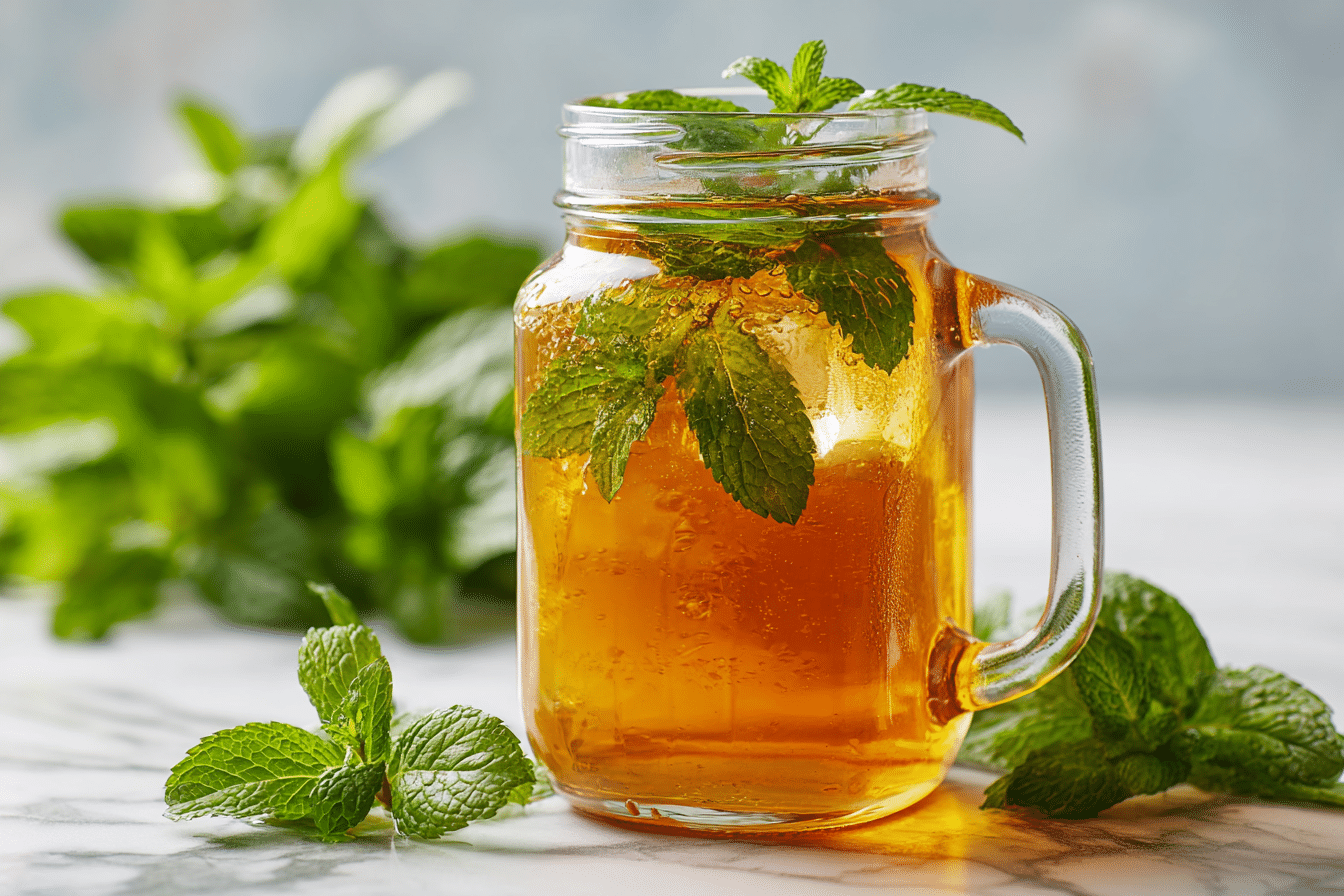Amish Meadow Tea Recipe is more than just a refreshing sip—it’s a ritual that speaks of summer afternoons, backyard gardens, and stories passed from one generation to the next.

If you’re someone who finds joy in herbal teas and simple, healing traditions, you’re going to love this nostalgic mint brew. I first learned to make it in Lancaster County, standing beside a quiet Amish grandmother who grew her own spearmint under rows of fluttering laundry lines.
For those already exploring homemade blends like my cortisol tea recipe for weight loss, this one’s a must-brew.
Key Takeaways
Amish Meadow Tea Recipe uses fresh spearmint leaves, water, and a touch of sweetener to create a naturally cooling herbal iced tea. It’s brewed strong, then chilled for a vibrant summer drink rooted in Amish tradition.
What You’ll Find Here
What Is Amish Meadow Tea Recipe?
Amish Meadow Tea Recipe is a mint-infused iced tea traditionally made by steeping large bundles of fresh spearmint in boiling water, then sweetening and chilling the liquid for a refreshing, herbal drink. It’s a staple in Pennsylvania Dutch kitchens during the summer months and a perfect way to enjoy the full, earthy brightness of garden-grown herbs.
This isn’t just mint tea—it’s meadow tea, bold and intensely aromatic, usually made with wild spearmint plucked fresh from the garden, not dried store-bought tea bags.
Ingredients (for 1 gallon)
- 3 cups fresh spearmint leaves (packed)
- 8 cups water
- ½–¾ cup sugar (adjust to taste)
Or try monk fruit, erythritol, or allulose for low-glycemic options - 6 cups cold water
- Ice to serve
- Lemon slices (optional, for garnish)
Tools You’ll Need
- Large stock pot
- Strainer or cheesecloth
- 1-gallon glass pitcher
- Wooden spoon
- Sharp knife (if adding citrus)
Directions
- Harvest & Wash: Pick 3 cups of fresh spearmint leaves. Rinse them well to remove any dirt or garden debris.
- Boil Water: Bring 8 cups of water to a boil in a large pot.
- Steep the Mint: Remove from heat. Add all the spearmint leaves and gently crush them with a spoon to release oils. Cover and steep for 30 minutes.
- Strain: Pour the liquid through a strainer or cheesecloth into a gallon pitcher to remove the leaves.
- Sweeten: While the tea is still warm, stir in your sweetener of choice until fully dissolved.
- Add Cold Water: Pour in 6 cups of cold water to dilute and cool the tea.
- Chill & Serve: Refrigerate for at least 4 hours. Serve over ice, with lemon if desired.

Amish Meadow Tea Recipe
- Total Time: 40 minutes
- Yield: 1 gallon 1x
- Diet: Vegan
Description
Amish Meadow Tea is a bold, aromatic mint-infused iced tea made from fresh spearmint leaves, a refreshing summertime staple in Pennsylvania Dutch kitchens.
Ingredients
- 3 cups fresh spearmint leaves (packed)
- 8 cups water
- ½–¾ cup sugar (or monk fruit, erythritol, or allulose)
- 6 cups cold water
- Ice to serve
- Lemon slices (optional, for garnish)
Instructions
- Pick and rinse 3 cups of fresh spearmint leaves.
- Boil 8 cups of water in a large pot.
- Remove from heat, add spearmint, crush gently, cover and steep for 30 minutes.
- Strain into a gallon pitcher.
- Add sweetener while tea is warm and stir until dissolved.
- Pour in 6 cups of cold water.
- Chill in the fridge for at least 4 hours.
- Serve over ice with lemon slices if desired.
Notes
For a low-glycemic version, substitute sugar with monk fruit, stevia, erythritol, or allulose. Avoid honey or maple syrup if you’re managing blood sugar levels.
- Prep Time: 10 minutes
- Cook Time: 30 minutes
- Category: Drinks
- Method: Stovetop
- Cuisine: Amish
Nutrition
- Serving Size: 1 cup
- Calories: 15
- Sugar: 3g
- Sodium: 0mg
- Fat: 0g
- Saturated Fat: 0g
- Unsaturated Fat: 0g
- Trans Fat: 0g
- Carbohydrates: 4g
- Fiber: 0g
- Protein: 0g
- Cholesterol: 0mg
Keywords: mint tea, iced tea, Amish, summer drink, herbal tea
For People with Diabetes: Sugar Substitutes
You can replace sugar with monk fruit, stevia, erythritol, or allulose. Avoid using honey or maple syrup, as they still spike blood sugar.
Why You’ll Love This Amish Meadow Tea Recipe
This tea isn’t just refreshing—it’s a sensory walk through the garden. One sip and you’re standing barefoot in dewy grass, hearing cicadas hum and screen doors slam. It’s an herbal hug, especially for those of us who lean on natural rituals for wellness.
When I lived briefly in Lancaster, I watched an Amish woman gently tie mint into bundles before sunrise. She brewed it in silence. Her movements—like her tea—were full of intention. That moment shaped how I connect to this tea today.
And when I came home? I planted my own spearmint patch in a terracotta pot on the porch. Every time I clip those leaves, I’m reminded: simple can be sacred.
If you’re into botanical brews, you’ll also want to try my cortisol tea recipe for weight loss.
What Makes Amish Meadow Tea Recipe So Special?
Amish meadow tea recipe is special because it blends centuries-old herbal practice with community and simplicity. It’s made with fresh spearmint, steeped slowly, and sweetened with care—a true farm-to-glass tradition.
Who It’s For
This Amish meadow tea recipe is for anyone craving a calming, caffeine-free drink made from real ingredients. It’s especially loved by:
- Gardeners with fresh mint on hand
- Parents looking for a no-junk, kid-friendly tea
- Those exploring herbal teas for wellness or digestion
- Folks who remember their grandmothers steeping herbs on the stove
If you’re new to herbal drinks, this is one of the easiest and most satisfying ways to start.
When to Brew It
This tea shines in the summer months, especially:
- Right after mint harvest in late spring through midsummer
- For Sunday picnics, front porch gatherings, or family potlucks
- As a non-alcoholic option for brunches or outdoor dinners
- During fasting or detox periods, thanks to its digestive qualities
I often make a batch on Saturday mornings. By late afternoon, it’s cold and fragrant—ready to pour into mason jars with lemon wheels, the way my grandmother did.
Tips for Making the Best Amish Meadow Tea
- Use spearmint, not peppermint. Spearmint gives a sweet, smooth flavor; peppermint can be too sharp.
- Harvest in the morning. The oils are strongest before the sun wilts the leaves.
- Steep covered. Trapping the steam keeps the volatile oils in the tea.
- Don’t skip the sweetener. Even a small amount balances the herbal bitterness.
- Let it chill slowly. Sudden cooling dulls the aroma; refrigerate instead of icing it hot.
These small steps make a big difference in flavor.
Top Tips for Perfecting Your Amish Meadow Tea Recipe
- Use a wooden spoon to gently bruise mint leaves while steeping—this releases the most flavor.
- Store in glass, not plastic. Mint oils cling to plastic and degrade quickly.
- If you love stronger flavor, steep longer or double the mint.
- Add lemon zest or a few sprigs of basil or lemon balm for variation.
Like many Amish recipes, this one is less about exact measurements and more about intention. Taste as you go. Adjust with love.

What Plant Is Used to Make Meadow Tea?
Amish meadow tea recipe calls for fresh spearmint, also known as Mentha spicata. It’s the signature herb used in traditional Amish meadow tea—not peppermint or dried mint blends.
What Spearmint Does for Amish Meadow Tea
The defining plant in any Amish meadow tea recipe is spearmint. This mint variety is softer and sweeter than peppermint. Where peppermint punches, spearmint soothes. It offers that gentle, green aroma you smell when brushing past an herb patch in July.
Spearmint grows easily—often too easily. Amish families traditionally plant it near garden fences where it can spread and thrive with little fuss. The mint is clipped in big bundles and brewed the same day for maximum flavor.
Unlike commercial mint teas, which are usually dried and packaged, this tea is made from fresh-cut leaves, still heavy with essential oils. That’s why an authentic Amish meadow tea recipe always starts in the garden, not the grocery store.
How to Identify the Right Mint for Your Amish Meadow Tea Recipe
If you’re foraging, shopping, or planting your own:
- Look for serrated leaves with a pointed tip and square stems.
- Smell matters: spearmint smells like Wrigley’s gum—light and sweet, not intense.
- Avoid peppermint for this recipe—it’s menthol-heavy and overpowers.
When I moved into my first house with a backyard, spearmint was the first herb I planted. It crept under the gate, popped up beside the rosemary, and refused to stay in its lane. But that’s exactly what makes it perfect for this Amish meadow tea recipe—plentiful, unruly, and full of life.
Substituting Spearmint in a Pinch
If you don’t have access to fresh spearmint:
- Try organic spearmint from the farmer’s market
- Use dried spearmint (½ cup dried = 3 cups fresh) as a last resort
- Grow it in a pot on a sunny windowsill—mint loves container gardening
Whatever you do, don’t use peppermint tea bags for an Amish meadow tea recipe. The flavor just won’t land right.

Is Amish Meadow Tea the Same as Mint Tea?
No, Amish meadow tea is not the same as generic mint tea. While both are mint-based, an Amish meadow tea recipe uses fresh spearmint leaves steeped and sweetened, whereas mint tea often refers to dried blends, sometimes mixed with other herbs.
Understanding the Difference
At a glance, you might think Amish meadow tea and mint tea are twins—but they’re not.
Mint tea is usually:
- Made with dried peppermint or a commercial mint blend
- Bagged and steeped like black or green tea
- Often served hot, without sweetener
- Standardized in taste, depending on the brand
Amish meadow tea, on the other hand:
- Uses fresh-cut spearmint, never dried
- Steeped in boiling water for a longer time
- Always chilled and sweetened
- Often brewed in large batches for family or community use
The key difference? Freshness and intention. An Amish meadow tea recipe is about using what’s grown nearby, brewing it strong, and pouring it over ice as a symbol of summer hospitality.
Why Fresh Mint Changes Everything
There’s a green clarity that comes from using freshly picked mint that no bagged tea can replicate. You taste the chlorophyll, the volatile oils, even a hint of the soil if you don’t rinse carefully enough. That raw vibrancy is central to any good Amish meadow tea recipe.
I remember brewing my first batch with store-bought peppermint and wondering why it lacked soul. Then I discovered spearmint at a local farmer’s market, brewed it that night, and everything changed. The tea wasn’t just better—it felt alive.
Can You Drink Amish Meadow Tea Hot?
Technically yes, but culturally? No.
An Amish meadow tea recipe is almost always served ice cold. In fact, some families keep it chilling in gallon jugs in the root cellar or icebox all summer long. It’s a drink designed to cool you down after morning chores or evening walks.
That said, if you’re steeping a smaller batch and want to sip it warm before chilling—go for it. Just don’t call it meadow tea until it’s had its time in the cold.
Meadow Tea Benefits
Yes, drinking Amish meadow tea offers health benefits including digestive support, natural cooling, and gentle stress relief. The spearmint used in the Amish meadow tea recipe is rich in antioxidants and soothing compounds.
Why This Tea Is More Than Just Refreshing
The beauty of a traditional Amish meadow tea recipe lies in its simplicity—and in that simplicity, there’s wellness.
Spearmint is known for:
- Soothing indigestion and bloating
- Calming the nervous system
- Reducing nausea and headaches
- Refreshing the breath naturally
Unlike caffeinated teas, Amish meadow tea is calming. It doesn’t spike your energy—it grounds you. No wonder Amish communities sip it after long days in the field.
Is Meadow Tea Good for Weight Loss?
It can help—especially if you use sugar substitutes like stevia or monk fruit. Mint aids digestion, may reduce appetite, and promotes hydration without calories.
I started drinking Amish meadow tea during the early part of my weight-loss journey, swapping it in for sodas and sugary drinks. It became a ritual: one jar in the afternoon sun, one at dusk. It wasn’t just about what I drank—it was what I didn’t need anymore.
For a nourishing companion to this tea, try my smoothie detox for weight loss or the apple peel recipe for weight loss.
Storing and Reheating Tips for Amish Meadow Tea
Store Amish meadow tea in the fridge, in glass containers, for up to 5 days. It should not be reheated—this tea is meant to be served chilled.
Best Storage Practices
To keep your Amish meadow tea recipe tasting fresh:
- Use glass pitchers or mason jars with lids
- Store immediately after cooling—don’t leave it on the counter
- Label your jars if making different mint variations
Avoid plastic containers—they absorb mint oil and alter the flavor.
Can You Freeze Meadow Tea?
Yes, you can freeze it in ice cube trays for future use. Add the frozen cubes to:
- Lemonade
- Sparkling water
- Iced green tea
This way, you’re not just preserving the flavor—you’re building layers in your drinks.
Reheating? Don’t.
An Amish meadow tea recipe isn’t designed for heat. Warming it dulls the mint, flattens the body, and alters the sweetness balance. Always serve it cold or iced, just like they do in the Amish countryside.

FAQs
How do you make meadow tea?
Yes, making meadow tea is simple and deeply rewarding. A classic Amish meadow tea recipe starts by steeping fresh spearmint leaves in boiling water, straining, sweetening, and then chilling it. The key is to use fresh spearmint, not dried mint or tea bags, for full flavor and aroma.
What is meadow tea good for?
Meadow tea is good for digestion, cooling the body, and soothing mild stress. In traditional Amish homes, meadow tea is served daily during the summer for its natural calm and refreshing taste. The spearmint used in the Amish meadow tea recipe contains antioxidants and mild antispasmodic properties that support stomach health.
What plant is used to make meadow tea?
Fresh spearmint (Mentha spicata) is the plant traditionally used in any authentic Amish meadow tea recipe. Spearmint grows abundantly in rural gardens and is clipped just before steeping to capture its vibrant oils and flavor. Other mints like peppermint are considered too harsh for this style of tea.
Is meadow tea the same as mint tea?
No, it depends on the preparation. While both use mint, mint tea often refers to commercial, dried, or blended teas. An Amish meadow tea recipe is unique—it uses only fresh spearmint, slow steeping, and cold serving. It’s richer, rounder, and more rooted in tradition than store-bought mint teas.
Can you dry mint for Amish meadow tea?
Technically yes, but traditional Amish meadow tea recipes call for fresh mint. Dried mint loses some of its oils and doesn’t yield the same smooth, bright flavor. If fresh isn’t available, you can substitute with high-quality dried spearmint—just adjust the quantity and expect a milder tea.
Conclusion
Amish meadow tea isn’t just a drink—it’s a ritual. From garden to glass, every step of the Amish meadow tea recipe carries memory, tradition, and purpose. Whether you’re steeping it for wellness, nostalgia, or pure refreshment, this tea invites you to slow down and savor what’s simple.
If you try this recipe, I’d love to hear how it turned out—or what twists you added from your own kitchen. Leave a comment below and share the story behind your brew.
And if you’re in a summer tea mood, don’t miss my green tea and lemonade recipe—another garden favorite.
Come hang out with me on Facebook and Pinterest—I’d love to see your creations!
